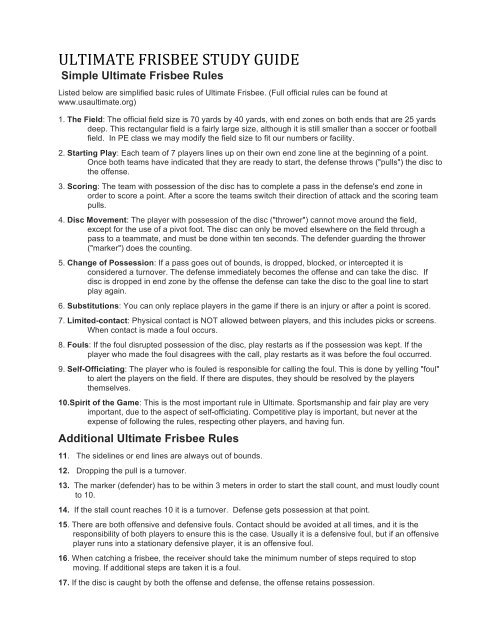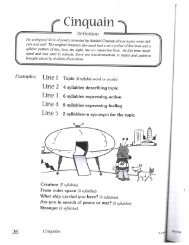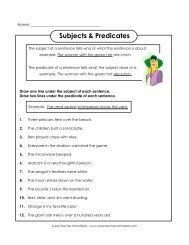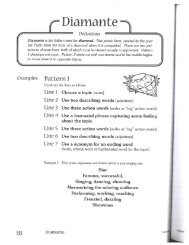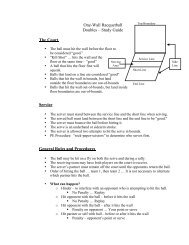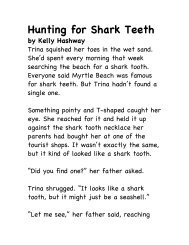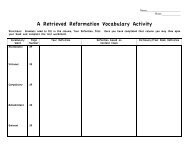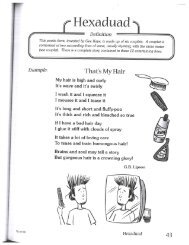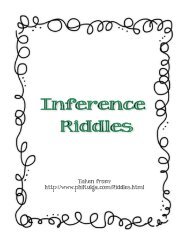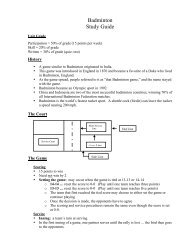ULTIMATE FRISBEE STUDY GUIDE
ULTIMATE FRISBEE STUDY GUIDE
ULTIMATE FRISBEE STUDY GUIDE
- No tags were found...
You also want an ePaper? Increase the reach of your titles
YUMPU automatically turns print PDFs into web optimized ePapers that Google loves.
<strong>ULTIMATE</strong> <strong>FRISBEE</strong> <strong>STUDY</strong> <strong>GUIDE</strong> Simple Ultimate Frisbee RulesListed below are simplified basic rules of Ultimate Frisbee. (Full official rules can be found atwww.usaultimate.org)1. The Field: The official field size is 70 yards by 40 yards, with end zones on both ends that are 25 yardsdeep. This rectangular field is a fairly large size, although it is still smaller than a soccer or footballfield. In PE class we may modify the field size to fit our numbers or facility.2. Starting Play: Each team of 7 players lines up on their own end zone line at the beginning of a point.Once both teams have indicated that they are ready to start, the defense throws ("pulls") the disc tothe offense.3. Scoring: The team with possession of the disc has to complete a pass in the defense's end zone inorder to score a point. After a score the teams switch their direction of attack and the scoring teampulls.4. Disc Movement: The player with possession of the disc ("thrower") cannot move around the field,except for the use of a pivot foot. The disc can only be moved elsewhere on the field through apass to a teammate, and must be done within ten seconds. The defender guarding the thrower("marker") does the counting.5. Change of Possession: If a pass goes out of bounds, is dropped, blocked, or intercepted it isconsidered a turnover. The defense immediately becomes the offense and can take the disc. Ifdisc is dropped in end zone by the offense the defense can take the disc to the goal line to startplay again.6. Substitutions: You can only replace players in the game if there is an injury or after a point is scored.7. Limited-contact: Physical contact is NOT allowed between players, and this includes picks or screens.When contact is made a foul occurs.8. Fouls: If the foul disrupted possession of the disc, play restarts as if the possession was kept. If theplayer who made the foul disagrees with the call, play restarts as it was before the foul occurred.9. Self-Officiating: The player who is fouled is responsible for calling the foul. This is done by yelling "foul"to alert the players on the field. If there are disputes, they should be resolved by the playersthemselves.10.Spirit of the Game: This is the most important rule in Ultimate. Sportsmanship and fair play are veryimportant, due to the aspect of self-officiating. Competitive play is important, but never at theexpense of following the rules, respecting other players, and having fun.Additional Ultimate Frisbee Rules11. The sidelines or end lines are always out of bounds.12. Dropping the pull is a turnover.13. The marker (defender) has to be within 3 meters in order to start the stall count, and must loudly countto 10.14. If the stall count reaches 10 it is a turnover. Defense gets possession at that point.15. There are both offensive and defensive fouls. Contact should be avoided at all times, and it is theresponsibility of both players to ensure this is the case. Usually it is a defensive foul, but if an offensiveplayer runs into a stationary defensive player, it is an offensive foul.16. When catching a frisbee, the receiver should take the minimum number of steps required to stopmoving. If additional steps are taken it is a foul.17. If the disc is caught by both the offense and defense, the offense retains possession.
18. The marker should maintain sufficient room or "disk space" around the thrower to give the throwerenough workable room. The marker may not obstruct the vision of the thrower. The defense may not“double team” the thrower.Common Ultimate Frisbee TermsForceA force is any tactic used by the defending team to force the thrower to throw to a specific area of the field.BackhandThe backhand is the standard throw for ultimate players. This throw has the players fingers curled underthe disc with the thumb on top. Right-handed throwers bring disc to left side of body.DumpA dump is a throw to a person who is usually used as a safety valve. Normally someone that is standingclose or even behind the thrower for an easy outlet.HammerA forehand grip that is thrown over the head is a hammer. This throw results in the disc flying upside downbefore tailing off at the end of its flight.PullA long throw that starts play and initiates the opposing team’s possession is called a pull. This is used in asimilar way to the kickoff in footballStackA stack is an offensive strategy that lines up offensive players one behind the other as they each break aseparate way in an attempt to get open.Stall countThe defensive player counts up to ten, and if the offensive player has not thrown the disc before he/shecounts to ten then it results in a turnover.ZoneDefensive strategy where the markers (defenders) are not responsible for an individual offensive player butinstead defend a portion of the field.One on One DefenseEach defender guards a specific offensive player.Ultimate Frisbee Skills & StrategiesThe Backhand: The backhand is the throw that most people know.• Grip the disc with a closed first, your fingers wrapped around the rim and the thumb on top (but notstraight out).• Your feet should be about shoulder width apart in line with your target.• Rotate your upper body away from you target while putting your weight on your back foot.• Then, shifting your weight forward with a step, rotate your upper body toward your target, whileswinging your arm and the disc forward in a smooth, level motion.• Snap your wrist as you release the disc at your target to put more spin on it. This motion is thesame as snapping a towel.The Forehand:• Grip the disc in your hand between your thumb and your index finger. Your thumb should be on topof the disc. Your middle and index fingers should be on the inside rim of the disc. For more stabilityextend your index finger toward the middle of the disc.• Your feet should be shoulder width apart and you should be facing your receiver.• Begin with your weight shifted to your pivot foot.• Draw your forearm and the disc back slightly.• Smoothly shift your weight to your non-pivot foot and turn your body, shoulders, and forearmforward as you snap your wrist, releasing the disc at your target.• Be sure to keep your arm parallel to the ground and your palm faced up while practicing this throw.Catching: Along with throwing, catching is one of the two most important skills. Make sure to always keepyour eyes on the disc until you have possession.
• One handed rim catch: One-hand should only be used when you cannot get two hands on thedisc. Examples where a one-handed catch may be necessary include very high throws, very lowthrows, and throws behind you.• Two handed rim catch: For throws below the waist and above the chin. With throws above thechin, the thumbs should be pointed down. For throws below the waist, the thumbs should bepointed up.• Pancake: The pancake is the most “sure” catch and should be used whenever possible. It is bestused for throws waist and chin level. Try to get your body in front of the disc.Cutting: Cutting is an essential Ultimate Frisbee skill. If you can create separation between you and yourdefender, you are much more likely to get the disc. Cutting is what will give you that separation. The mostessential element of a cut is a sharp change in direction. There are different ways to set up your defenderon a cut. The two most common ways are:1. Drive at your defender to get them off balance and then cut to your desired location.2. Drive away from your defender. Once they commit to following you, cut underneath or behind them.Offensive StrategyThe Stack: There are several offensive sets in Ultimate Frisbee. Offensive sets are designed to createspace so that players can cut into open areas. The most basic and popular offensive set is the Stack. In astack, all the offensive players are lined up in the middle of the field. The closest player should start about8-10 yards up field of the throwers. Every player in the stack should be separated by 3-5 yards, givingeveryone enough space to cut without causing picks. This should create space on either side of the stackfor cutting. The stack is in the “dead zone” while the spaces on the sides are called the “cutting zones.”After you make a cut, be sure to clear hard back into the stack to give the next cutter space to cut.*Information in study guide taken from www.castonline.ilstu.edu and www.usaultimate .org


